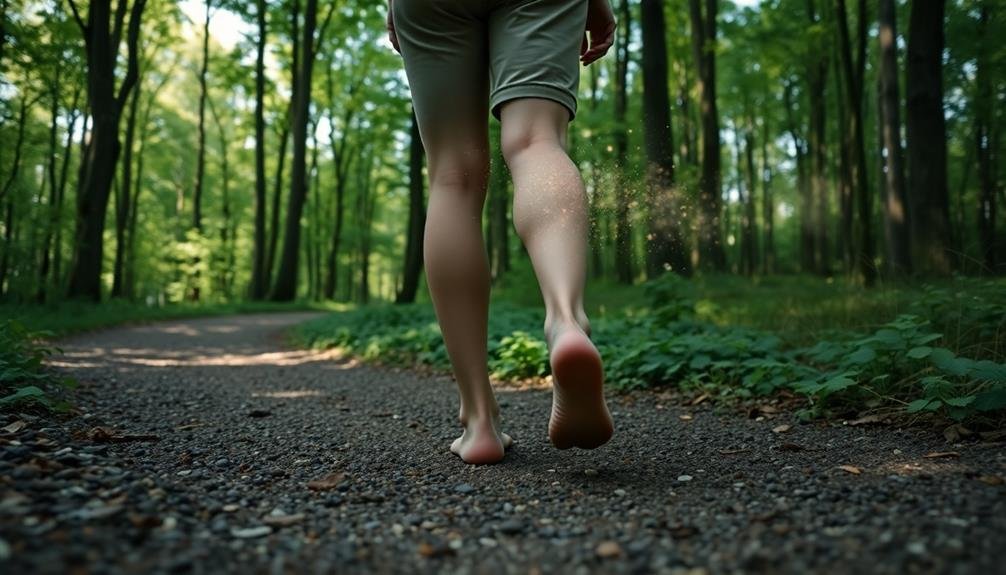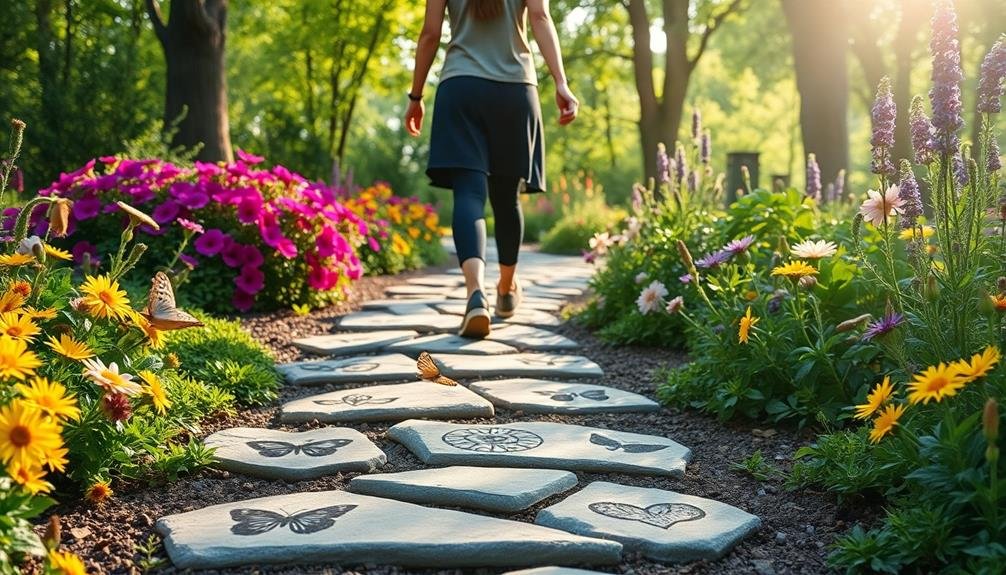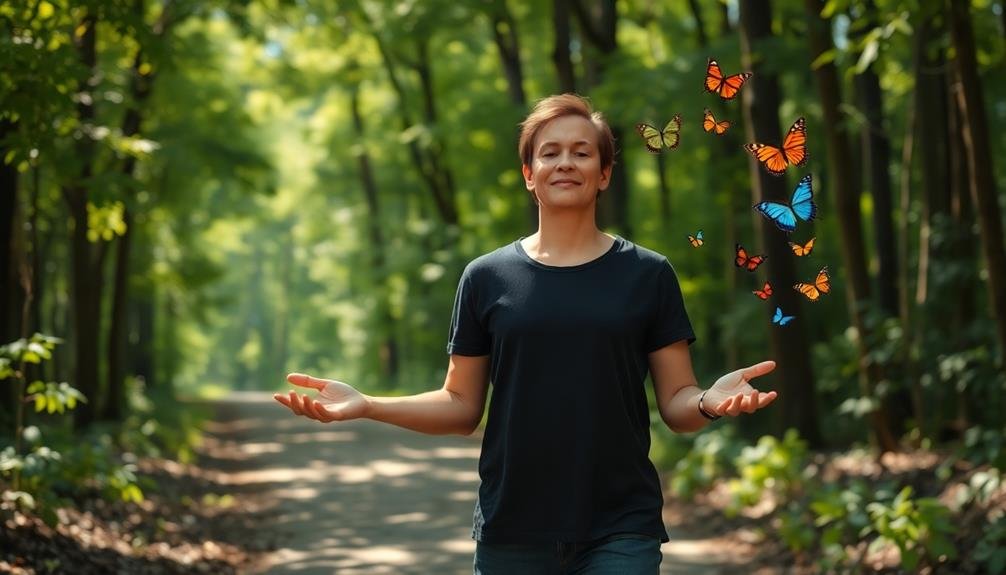Walking meditation combines movement with mindfulness to ease anxious thoughts. You can try mindful breathing, synchronizing your breath with your steps. Body scanning helps you focus on physical sensations, while mantra repetition anchors your mind. Nature observation engages your senses, and practicing gratitude with each step shifts your focus positively. A sensory awareness stroll heightens your connection to the environment. Loving-kindness meditation cultivates compassion, and counting footsteps centers your attention. Visualizing the release of anxiety can be powerful, as can engaging all five senses during your walk. These techniques offer a path to inner calm and mental clarity.
Key Takeaways
- Breath synchronization with steps creates a calming rhythm and reduces anxiety during walking meditation.
- Body scan techniques while walking enhance awareness and help release physical tension associated with anxious thoughts.
- Labeling thoughts without judgment during walks increases self-awareness and reduces emotional reactivity to anxious thinking.
- Mantra repetition synchronized with steps provides a mental anchor and helps redirect focus from anxious thoughts.
- Visualization exercises, like imagining anxiety as dissipating clouds, can effectively release tension during walking meditation.
Mindful Breathing While Walking

During your walking meditation, focus on your breath as you move. Synchronize your breathing with your steps, creating a rhythm that calms your mind. As you inhale, take two or three steps, and as you exhale, take two or three steps. This simple practice helps you stay present and anchors your attention to the present moment.
Pay attention to the sensations of breathing. Notice the air entering your nostrils, filling your lungs, and then leaving your body. If your mind wanders, gently bring it back to your breath and footsteps. You don't need to control your breathing; just observe it naturally.
As you continue walking, you may find that your breath becomes deeper and more relaxed. This can help reduce anxiety and promote a sense of calm.
If you're feeling particularly stressed, you can try counting your breaths as you walk. Inhale for a count of four steps, hold for two steps, and exhale for six steps. This technique can further deepen your relaxation and focus.
Body Scan During Movement

A body scan during movement can deepen your walking meditation practice. As you walk, shift your attention systematically through different parts of your body, starting from your feet and moving upwards. Notice the sensations in your toes, the pressure on your soles, and the movement of your ankles. Progress to your calves, knees, and thighs, observing any tension or relaxation.
Continue upwards, focusing on your hips, lower back, and abdomen. Feel the subtle shifts in your core as you move. Pay attention to your chest, noticing your breath and heartbeat. Scan your shoulders, arms, and hands, allowing them to relax if they're tense.
Finally, bring awareness to your neck, face, and scalp. Throughout this process, maintain a steady walking pace. If you notice discomfort or tension in any area, don't try to change it. Simply acknowledge it and move on.
This practice helps you stay present in your body, reducing anxious thoughts by grounding you in physical sensations. It also improves body awareness and can highlight areas of tension you mightn't have noticed otherwise.
Mantra-Based Walking Meditation

Mantras can transform your walking meditation into a powerful, focused practice. By repeating a specific phrase or word as you walk, you'll anchor your mind and reduce anxious thoughts. Choose a mantra that resonates with you, such as "peace," "calm," or "I am present." Synchronize your mantra with your breath or footsteps, creating a rhythmic pattern that enhances your focus.
As you begin your mantra-based walking meditation, start slowly and deliberately. Match each syllable of your chosen mantra to a step or breath. For example, if using "I am calm," you might say "I" on your left step, "am" on your right, and "calm" on your next left step.
Here's a quick guide to mantra selection and use:
| Mantra Type | Examples | Benefits |
|---|---|---|
| Single-word | "Peace," "Calm" | Simple, easy to repeat |
| Affirmations | "I am strong," "I choose joy" | Boost confidence, shift mindset |
| Traditional | "Om mani padme hum" | Connect with spiritual practices |
Nature Observation Walk

During a nature observation walk, you'll engage your senses mindfully to connect with your surroundings.
Focus on the sights, sounds, smells, and textures of the natural environment as you move through it.
This practice can help you feel grounded and appreciate the biodiversity around you, from the smallest insect to the tallest tree.
Mindful Sensory Engagement
While exploring the practice of walking meditation, mindful sensory engagement through nature observation walks offers a unique and enriching experience. As you stroll, focus on each of your senses, one at a time. Begin with sight, observing the colors, shapes, and movements around you. Next, tune into your sense of hearing, noting the rustling leaves, chirping birds, or distant sounds.
Pay attention to the sensations on your skin, like the warmth of sunlight or the cool breeze. Breathe deeply, taking in the scents of nature – flowers, earth, or fresh air. Finally, if appropriate, engage your sense of taste by sampling edible plants (only if you're certain they're safe).
To enhance your practice, use this table as a guide:
| Sense | Focus Points |
|---|---|
| Sight | Colors, shapes, movements |
| Hearing | Natural sounds, ambient noises |
| Touch | Temperature, textures |
| Smell | Floral scents, earthy aromas |
| Taste | Safe, edible plants (optional) |
Grounding Through Biodiversity
Building on the concept of mindful sensory engagement, grounding through biodiversity takes your nature observation walk to a deeper level.
As you stroll, focus on the diverse array of plant and animal life around you. Notice the intricate patterns of tree bark, the varied shapes of leaves, and the different bird songs filling the air. This practice helps shift your attention away from anxious thoughts and onto the rich tapestry of life surrounding you.
To deepen your connection with nature and enhance your grounding experience, try these biodiversity-focused activities:
- Identify five different plant species, noting their unique characteristics.
- Count the number of distinct bird calls you hear during your walk.
- Observe insects and their behaviors, paying attention to their interactions with plants.
Gratitude Steps

With each step you take, focus on something you're grateful for. This practice, known as gratitude steps, combines the physical act of walking with mindful appreciation. As you move forward, mentally list specific things you're thankful for, matching each item to a step. Start with simple blessings like good health, loving relationships, or a safe home.
As you continue walking, explore deeper into your gratitude. Acknowledge the small pleasures in life: a warm cup of coffee, a beautiful sunset, or a kind gesture from a stranger.
Don't rush through this process; take your time to fully experience the positive emotions associated with each grateful thought. If you find your mind wandering, gently bring your attention back to your steps and gratitude practice.
You can also synchronize your breathing with your gratitude steps, inhaling as you think of something you're thankful for, and exhaling as you take a step. This technique helps to ground you in the present moment and amplify the calming effects of your walk.
Labeling Thoughts Exercise

The labeling thoughts exercise offers a powerful way to enhance your walking meditation practice. As you stroll, you'll learn to observe and categorize your thoughts without judgment. This technique helps create distance between you and your anxious thoughts, allowing you to respond more calmly to mental chatter.
To begin, choose a quiet path and start walking at a comfortable pace. As thoughts arise, simply label them in your mind. For example, if you're worried about work, label it "planning." If you're remembering a past event, label it "memory." The key is to acknowledge the thought briefly and return your focus to the present moment.
Here are three benefits of the labeling thoughts exercise:
- Increased self-awareness
- Reduced emotional reactivity
- Improved ability to stay present
As you practice, you'll likely notice patterns in your thinking. This awareness can help you identify triggers for anxious thoughts and develop strategies to manage them more effectively.
Sensory Awareness Stroll

During your sensory awareness stroll, you'll engage all five senses to mindfully notice your surroundings.
As you walk, pay attention to the sights, sounds, smells, textures, and even tastes in your environment.
This practice helps ground you physically, connecting you to the present moment through your body's sensory experiences.
Engage Your Five Senses
A sensory awareness stroll engages all five of your senses, heightening your connection to the present moment. As you walk, focus on each sense individually, allowing yourself to fully experience your surroundings.
Start with sight, observing the colors, shapes, and movements around you. Notice the play of light and shadow, the varying textures of surfaces, and the subtle changes in your environment.
Next, tune into your sense of hearing. Listen for both loud and quiet sounds, from rustling leaves to distant traffic or birdsong.
As you continue your walk, engage your other senses:
- Touch: Feel the ground beneath your feet, the air on your skin, and the textures of objects you pass.
- Smell: Inhale deeply, identifying various scents in the air, from flowers to freshly cut grass.
- Taste: Notice any lingering flavors in your mouth or the taste of the air you're breathing.
Notice Surroundings Mindfully
Expanding on the concept of sensory awareness, mindful observation of your surroundings takes your walking meditation to a deeper level.
As you stroll, focus on the details around you without judgment or analysis. Notice the shapes of buildings, the patterns of leaves on trees, or the way sunlight filters through clouds.
Pay attention to the movement of people and animals in your vicinity. Observe their gestures, expressions, and interactions without getting caught up in stories about them.
Watch how the wind affects objects, causing leaves to rustle or flags to wave. Take note of colors, textures, and contrasts in your environment.
As you practice this mindful observation, you'll likely find that your anxious thoughts begin to recede. Your mind becomes occupied with the present moment rather than worrying about the future or ruminating on the past.
This shift in focus can bring a sense of calm and grounding.
Ground Yourself Physically
Grounding yourself physically during a sensory awareness stroll can deepen your walking meditation practice. As you walk, focus on the sensations in your feet and legs. Feel the weight of your body shift from one foot to the other with each step. Notice the texture of the ground beneath you—whether it's soft grass, rough pavement, or smooth tiles.
Pay attention to your breath as you move. Sync your breathing with your steps, inhaling for two or three strides and exhaling for the same count. This rhythmic breathing can help calm your mind and anchor you in the present moment.
To further ground yourself physically, try these techniques:
- Pause occasionally and stand still, feeling the earth supporting you.
- Gently swing your arms as you walk, noticing the subtle movements in your shoulders and back.
- Touch nearby objects—a tree trunk, a wall, or a railing—to engage your sense of touch.
Loving-Kindness Walking Practice

Loving-kindness walking practice combines the benefits of movement with the cultivation of compassion and goodwill. As you walk, focus on generating feelings of love and kindness towards yourself and others. Begin by silently repeating phrases like "May I be happy" or "May I be peaceful" with each step. Synchronize these thoughts with your breath and footsteps to create a rhythmic, meditative state.
After a few minutes, shift your focus to someone you care about. Direct your well-wishes towards them, saying "May you be safe" or "May you be healthy." Gradually expand your circle of compassion to include acquaintances, strangers, and even difficult people in your life.
As you walk, imagine sending out waves of kindness and goodwill to all beings around you. This practice helps reduce anxiety by redirecting your focus from worries to positive intentions. It fosters a sense of connection and empathy, which can ease feelings of isolation often associated with anxiety.
Counting Footsteps
When practicing counting footsteps meditation, you'll focus intently on each step you take.
You can synchronize your breath with the counting, inhaling for a certain number of steps and exhaling for another.
To add variety and maintain engagement, you might experiment with different counting patterns, such as counting to ten repeatedly or counting backwards.
Focus on Each Step
As you commence your walking meditation journey, focusing on each step through counting footsteps can be a powerful technique. This method encourages mindfulness and helps anchor your attention to the present moment, effectively quieting anxious thoughts.
To practice this technique, begin by choosing a quiet path or area where you can walk undisturbed. As you walk, direct your attention to the sensation of each foot as it touches the ground. Count your steps silently, starting from one and continuing up to ten. Once you reach ten, start over at one. If you lose count or become distracted, simply begin again at one without judgment.
To enhance your practice, try these variations:
- Coordinate your breath with your steps, inhaling for a certain number of steps and exhaling for another.
- Use descriptive words for each step, such as "lifting," "moving," and "placing."
- Alternate between counting steps and focusing on other sensations, like the feeling of the air on your skin.
Synchronize Breath With Counting
Synchronizing your breath with counting footsteps elevates your walking meditation practice to a new level of mindfulness. This technique helps you maintain focus and deepen your connection to the present moment. As you walk, count your steps in rhythm with your breath. For example, inhale for four steps, then exhale for four steps. You can adjust this ratio based on your natural breathing pattern and walking pace.
Start by choosing a comfortable walking speed. As you begin, take a few deep breaths to center yourself. Then, focus on your breath and start counting your steps. Inhale as you count "one, two, three, four," and exhale as you count the next four steps. If your mind wanders, gently bring your attention back to your breath and footsteps.
This method not only helps calm anxious thoughts but also improves your overall awareness. You'll notice how your body moves, how your feet connect with the ground, and how your breath flows.
With practice, you'll find it easier to maintain this synchronization, allowing you to enter a meditative state more easily during your walks.
Vary Counting Patterns
Three distinct counting patterns can enhance your walking meditation practice. By varying your counting technique, you'll keep your mind engaged and prevent boredom during your walks.
These patterns also help you maintain focus and rhythm, which are essential for effective meditation.
Try these counting patterns to diversify your practice:
- Count to four repeatedly: Take four steps, counting each one, then start over. This simple pattern helps establish a steady pace and promotes mindfulness.
- Alternate odd and even numbers: Count odd numbers on your left foot and even numbers on your right. This pattern challenges your mind and improves coordination.
- Count backwards from 10 to 1: Start at 10 and count down with each step. When you reach 1, begin again at 10. This reverse counting keeps your mind alert and present.
As you experiment with these patterns, pay attention to how each affects your mental state. You might find that one pattern is particularly effective at calming anxious thoughts or improving your focus.
Don't hesitate to create your own counting patterns that resonate with your walking rhythm and meditation goals. Remember, the key is to find a method that keeps you present and mindful throughout your walk.
Visualizing Anxiety Release

Tension melts away with each step during a focused walking meditation. As you practice visualizing anxiety release, imagine your worries as tangible objects you can shed with each footfall. Picture your anxious thoughts as leaves clinging to your body, then watch them fall away and scatter in the breeze as you walk.
You can also envision your stress as a heavy backpack you're carrying. With each step, feel it getting lighter until you've completely shed its weight.
Another effective technique is to visualize your anxiety as dark clouds surrounding you. As you walk, imagine these clouds dissipating, revealing clear blue skies and sunshine.
You might also picture your tension as tight knots in your muscles. With each stride, feel these knots loosening and unraveling.
For a grounding experience, visualize roots growing from your feet into the earth with every step, drawing out your anxiety and replacing it with calm energy.
Frequently Asked Questions
How Long Should a Walking Meditation Session Last for Optimal Benefits?
You'll benefit most from a 15-30 minute walking meditation session. However, even 5-10 minutes can be effective. Start with what's comfortable for you and gradually increase the duration as you become more familiar with the practice.
Can Walking Meditation Be Practiced Indoors or in Urban Environments?
Yes, you can practice walking meditation indoors or in urban areas. You'll find it's adaptable to various settings. Try pacing in your home, walking in a mall, or strolling through city parks. Focus on your steps and breath.
Is It Safe to Practice Walking Meditation With Eyes Closed?
It's not safe to practice walking meditation with your eyes closed. You risk tripping, bumping into objects, or injuring yourself. Instead, keep your eyes open and maintain a soft gaze to stay aware of your surroundings.
How Does Walking Meditation Compare to Seated Meditation for Anxiety Relief?
You'll find both walking and seated meditation can ease anxiety. Walking meditation adds movement, which may help release physical tension. Seated meditation allows deeper focus. Try both to see which works best for your anxiety relief needs.
Can Walking Meditation Be Combined With Other Forms of Exercise?
You can definitely combine walking meditation with other exercises. Try incorporating it into your jogging routine, or practice mindful movement during yoga. It's versatile and can enhance your overall workout experience, boosting both physical and mental benefits.
In Summary
You've now learned 10 powerful walking meditation techniques to help calm your anxious mind. By incorporating these practices into your daily routine, you'll find yourself better equipped to manage stress and find inner peace. Remember, it's not about perfection but consistency. Start small, be patient with yourself, and gradually increase your practice. With time, you'll notice a significant shift in your mental state. Keep walking, keep breathing, and keep growing.





Leave a Reply